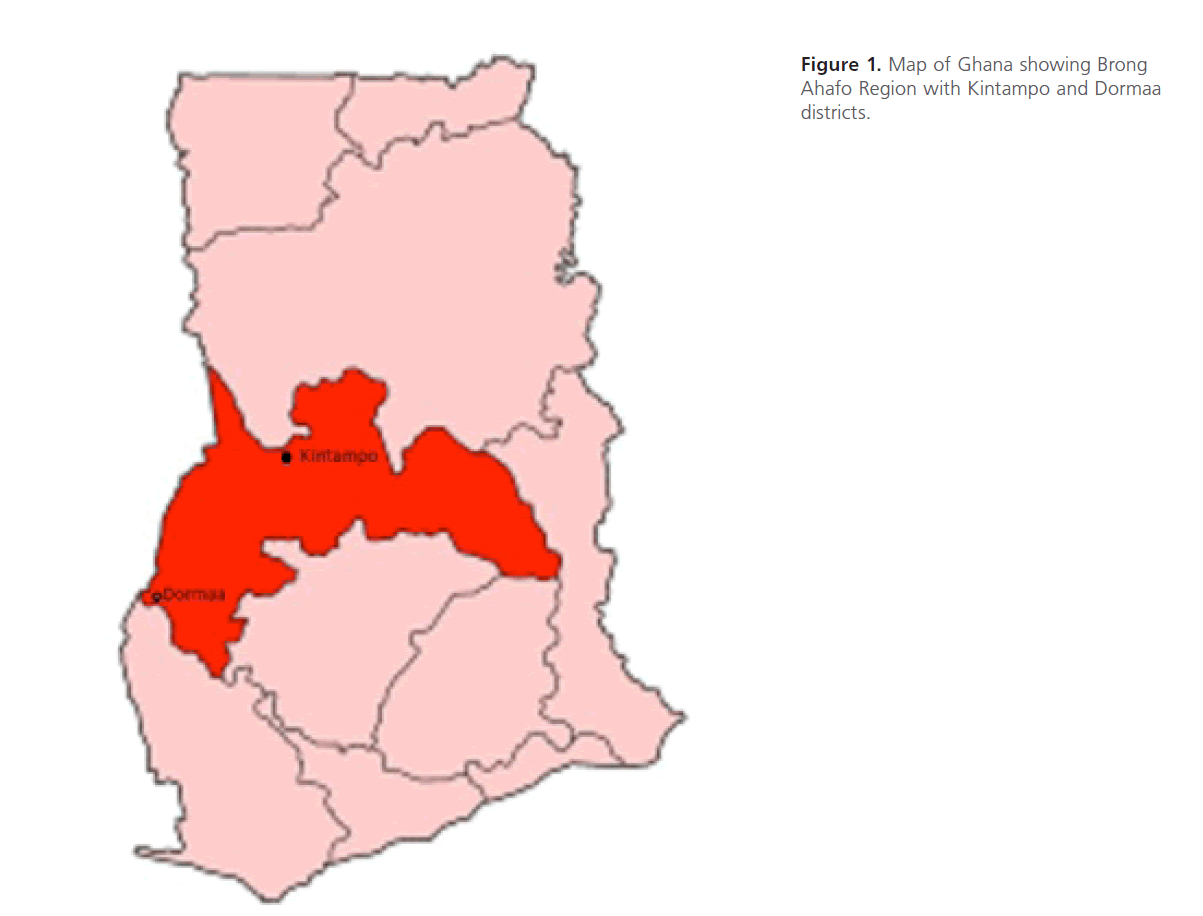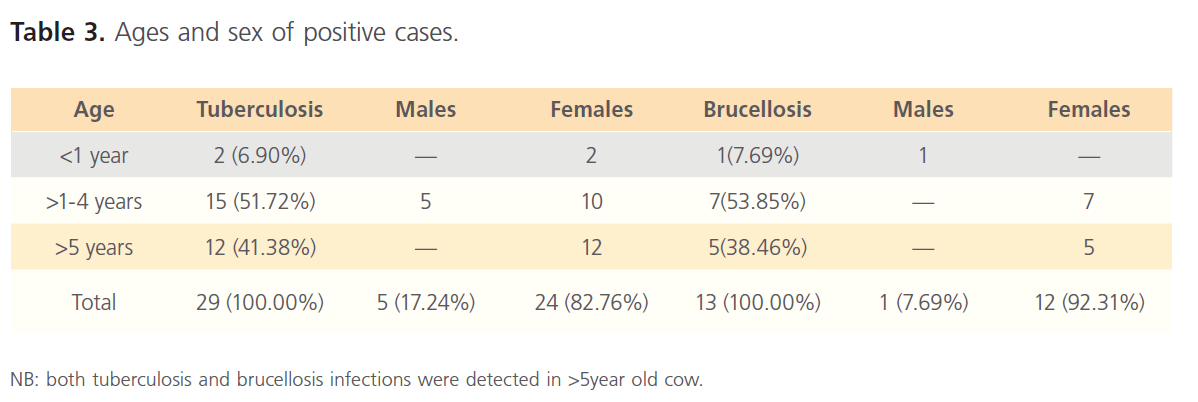Keywords
brucellosis, bovine tuberculosis, cattle, Ghana.
Introduction
Bovine brucellosis and tuberculosis still remain important zoonoses that need to be controlled in most developing countries especially in Sub-Saharan nations. Bovine tuberculosis (BTB) is caused by M. bovis a Mycobacterium closely related to the human pathogen M. tuberculosis, both belonging to the Mycobacteria Tuberculosis Complex (MTC) [1]. Brucellosis is a bacterial infectious disease caused by Brucella spp, with B. abortus primarily affecting cattle. The disease belongs to the world’s major zoonoses [2]. Both diseases can be readily transmitted to humans via close contact with infected animals or animal tissue such as placental membranes in the case of Brucellosis [3].
Besides being a public health threat, both diseases can have serious economic impacts not only for the animal owners, but also for the regional and national economies through decreased animal productivity and market/trade impairments [4-5].
Information on the prevalence of these important zoonotic diseases in West African countries other than Nigeria had been scanty in literature [6]. In Ghana however, there had been very little information on field and abattoir investigation of these diseases in regions other than Greater Accra which are also at the receiving end in the cattle production and marketing chain in Ghana. Though, the study of BTB in Greater Accra showed a low endemicity of the disease [7], the distribution and the prevalence of the diseases at animal level in cattle kept under traditional husbandry in Ghana had not been accorded due attention. This investigation provides the point prevalence of BTB and brucellosis in small herds under traditional husbandry system in Brong Ahafo region of Ghana.
Material and Methods
Study area and animal husbandry system
The study was carried out between February to March of 2012. Brong Ahafo Region was selected on the basis of livestock production potential and being at the receiving end in the cattle production and marketing chain in Ghana. The climate of the area is described as subhumid zone with an average annual rainfall ranging from 500 mm to 1150 mm. It has 27 districts of which cattle are concentrated more in Kintampo districts located between latitudes 8º45’N and 7º45’N and Longitudes 1º20’W and 2°1’E and Dormaa district which lies within longitudes 3° West and 3° 30’ West and latitudes 7° North and 7° 30’ North. Agricultural production system is of mixed crop and livestock production. The local breed includes Sanga (cross between local and zebu breeds) are often found grazing on communal land.
Sampling scheme
The districts were purposely selected based on the concentration of cattle in the area and 17 herds were randomly selected among them. In each herd, cattle more than a year and above were recruited. A total of 444 cattle were tested for tuberculosis and brucellosis. Assuming a prevalence of 10% in cattle, 384 animals would be required to estimate the prevalence with a precision of 3% (alpha= 5%). Information pertaining to individual animals such as age, sex and breed was recorded. The single comparative intradermal tuberculin (SCIT) test was used for the diagnosis of tuberculosis [8]. For brucellosis, the same animals were sampled, using Rose Bengal Plate (RBP) test to detect Brucella spp. specific antibodies [8].
Data analysis
The proportions of positive SCIT and RBP tests were analysed in multivariate logistic regression models, using the breed, sex and age class of the animals as discrete explanatory variables. The herd prevalences were analysed in similar models. Herd with at least one positive animal, were considered positive.
Results of tuberculosis and brucellosis test
Positive skin reaction to bovine PPD was recorded in 29 cattle. The statistical analysis of positive bovine PPD reactions in cattle gave an estimated prevalence of 6.5% (Table 1) whereas the herd prevalence was 64.71%. No significant difference was found in bovine PPD reactivity of cattle of different age, sex and breed) Table 3. Positive reaction to Rose Bengal was recorded in 13 cattle. The statistical analysis of positive reactors in cattle gave an estimated prevalence of 2.93% (Table 2 and 3) whereas the herd prevalence was 35.29%. No significant difference was found in positive reactors of different age, sex and in their locations. The positive reactors were observed more in Dorma district (Table 2) and in cows more than the bulls (Table 3). The infection also increased with age as shown in Table 3 with cases commonly observed between age 1 and 4. The two diseases were detected in a >5year old cow giving an estimated prevalence of 0.23%.

Figure 1: Map of Ghana showing Brong Ahafo Region with Kintampo and Dormaa districts.

Table 1: Occurrence of tuberculosis and brucellosis cases in cattle.

Table 2: Occurrence of tuberculosis and brucellosis cases in cattle in Dorma and Kitampo districts.

Table 3: Ages and sex of positive cases.
Discussion
Cases of brucellosis and tuberculosis have been reported separately previously in Ghana but this study described for the first time the serology involving the two important zoonoses in Ghana. The point prevalence of Brucellosis in this study revealed a low infection in cattle herds in Brong Ahafo as compared to previous reports in other parts of Ghana [7], Nigeria [9, 10] and Zambia (6.3%) [5]. The prevalence of tuberculosis in cattle is also high compared to 3.85% reported in Malawi [11]; 1.3% in Tanzania [12]; 1.4% reported in Uganda [13].
In cattle, the SCIT test results indicate that bovine tuberculosis is present however, a small proportion of the sampled cattle seem to be negative for Mycobacterium bovis, despite the absence of control measures. In addition, the infection rate in both diseases seems to increase with age especially between 1 to 4 years old cattle [2] which also buttress the carrier status of both infections and the possible consistent field exposure. The fact that the infection were observed in females more could be due to the fact that more females were examined and most herdsmen keep cows longer for breeding and the longer the time of exposure, the more the possibility of detecting reactors and likelihood to excrete much pathogen through the nasal, vaginal, digestive and milk routes [14]. This is unlike the reports of Tschopp et al. [3] that showed that bulls and oxen have a higher risk of being BTB reactors than females. Another possible reasons for the low infection rate in cattle of the study area could be related to the breed (local and cross breeds, Sanga) being more resistant than exotic breeds.
Despite the RBP test might lack sensitivity [14], the results should be adequate to evaluate the occurrence of B. abortus in cattle especially in poor resource areas where there is no vaccination, and these show that there is a very low circulation of Brucella spp. in the study areas.
The occurrence of both tuberculosis and brucellosis in a five year old cow further buttress the presence of combine infection which may suggest a possible relationship or interaction between the two zoonotic diseases. Though the estimated prevalence of the two diseases was relatively low in the districts investigated, effort should be geared towards a more comprehensive surveillance and prevention of the two diseases in the cattle population in Ghana because of the continual unrestricted animal movement in the country which might result in an increased transmission to humans.
64
References
- Mostowy, S., Inwald, J., Gordon, S., Martin, C., Warren, R. et al. Revisiting the evolution of Mycobacterium bovis. J Bact. 2005; 187: 6386-6395.
- Boukary, AR., Saegerman, C., Abatih, E., Fretin, D., Alambe’djiBada, R. et al. Seroprevalence and Potential Risk Factors for Brucella Spp. infection in Traditional Cattle, Sheep and Goats Reared in Urban, Periurban and Rural Areas of Niger. PLoS ONE 2013; 8 (12): e83175. doi:10.1371/journal. pone.0083175.
- Tschopp, R., Schelling, E., Hattendorf, J., Aseffa, A., Zinsstag, J. Risk factors of bovine tuberculosis in cattle in rural livestock production systems of Ethiopia. Prev Vet Med. 2009; 89: 205-211.
- Marcotty, T., Matthys, F., Godfroid, J., Rigouts, L., Ameni, G. et al. Zoonotic tuberculosis and brucellosis in Africa: Neglected zoonoses or minor public-health issues? The outcomes of a multi-disciplinary workshop. Ann Trop Med Parasit. 2009; 103: 401-411.
- Muma, JB., Samui, KL., Siamudaala, VM., Oloya, J., Matope, G. et al. Prevalence of antibodies to Brucella spp. and individual risk factors of infection in traditional cattle, goats and sheep reared in livestock-wildlife interface areas of Zambia. Trop Anim Health Prod. 2006; 38: 195-206.
- Akakpo, AJ., Bornarel, P. Epidemiology of animal brucellosis in Tropical Africa: Clinical, serological, and bacteriological surveys. Res Sci Tech. 1897; 6: 981-1027.
- Kubuafor, DK., Awumbila, B., Akanmori, BD. Seroprevalence of brucellosis in cattle and humans in the Akwapim-South district of Ghana: Public health implications. Acta Trop. 2000; 76: 45-48.
- OIE. Manual of diagnostic tests and vaccines for terrestrial animals (mammals, birds and bees). Office International des Epizooties (OIE); 2008.
- Ocholi, RA., Kwaga, JK., Ajogi, I., Bale, JO. Abortion due to Brucella abortus in sheep in Nigeria. Rev Sci Tech. 2005; 24 (3):973-979.
- Cadmus, SI., Adesokan, HK., Adedokun, BO., Stack, JA. Seroprevalence of bovine brucellosis in trade cattle slaughtered in Ibadan, Nigeria, from 2004-2006. J S Afr Vet Assoc. 2010; 81 (1): 50- 53.
- Bedard, BG., Martin, SW., Chinombo, D. A prevalence study of bovine tuberculosis and brucellosis in Malawi. Prev Vet Med. 1993; 16 (3): 193-205.
- Shirima, GM., Kazwala, RR., Kambarage, DM. Prevalence of bovine tuberculosis in cattle in different farming systems in the eastern zone of Tanzania. Prev Vet Med. 2003; 57 (3): 167-172.
- Oloya, J., Opuda-Asibo, J., Djønne, B., Muma, JB., Matope, G. et al. Responses to tuberculin among Zebu cattle in the transhumance regions of Karamoja and Nakasongola district of Uganda. Trop Anim Health Prod. 2006, 38 (4): 275-283.
- Tanko, PN., Emikpe, BO., Sabri, MY. Evaluation of the shedding routes and serological patterns in experimentally-induced Brucella melitensis infection in dexamethasone-treated andtransport-stressed goats. Vet World. 2013; 6 (9): 686-692.









